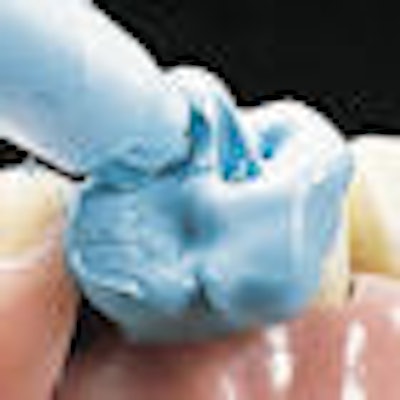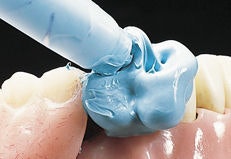
When a patient needs a new crown under an existing removable partial denture (RPD), the dentist faces a dilemma.
Ideally, you would recommend a new partial to go with the crown. But that doesn't sit well with many patients, especially in today's economy. If you need an out-of-stock part for your year-old car, the mechanic doesn't sell you a whole new car.
Even borrowing the RPD for a day or two to send to the lab -- which is what most of us learned in dental school -- isn't very convenient for the patient. That's like sending your car in with the order for the new part.
Fortunately, two easy alternatives have very high success rates.
The first is used by prosthodontist Joseph Massad, D.D.S. Dr. Massad lectures internationally and practices in Tulsa, OK. The first step, he told DrBicuspid.com, is to prep the tooth. Then:
Be certain the RPD fits well and is completely seated. Make sure the occlusion is good. "Use Regisil (Dentsply International) instead of Blu-Mousse (Parkell) [for bite registration] because it doesn't have any play or bounce," he stressed. "Now, you have your index of the occlusion."
Using DuraLay inlay resin (Reliance Dental Manufacturing) (yes, the stuff we made posts with in dental school), fabricate a temporary crown on the preparation with the RPD in place. It doesn't have to be dental school perfect, but "make sure you're touching the lingual, distal, and labio-buccal surface" of the framework, Dr. Massad said. This nicely duplicates the shape of the clasps. If there's a rest prep, include that indentation.
Take a full-arch polyvinyl impression of the RPD and DuraLay temporary. "If it's a free-ended extension, your impression must be fully anatomical with border molding" Dr. Massad added. Take an opposing impression and a normal crown and bridge impression of the tooth without the RPD. Send the index and three impressions to the lab.
The technician will put the DuraLay temp inside the polyvinyl impression and pour. The technician uses this "coping" as your die for the wax-up.
This works well, Dr. Massad said, but "the absolute best way to do it is to do your own lab work, but then we wouldn't get any dentistry done!"
The other method comes courtesy of Charles Sallie, C.D.T., the production manager and assistant lab manager for Crown Dental Studios in Shreveport, LA. Sallie, who has 50 years of experience in the business, recommends the Blu-Mousse technique.
"We have a less than 1.5% failure rate with this technique," he said.
 |
| When using the Blu-Mousse technique, after creating the crown/bridge impression, inject Blu-Mousse over the preparation and continue expressing the material until the clasps and occlusal rests are completely covered. Because Blu-Mousse has the consistency of whipped cream, it will not flow, so there is no need to use a confining tray. Image courtesy of Allen Weiner, D.M.D., Medfield, MA. |
The full step-by-step guide, along with illustrative slides, can be accessed on the Crown Web site, but here's a summary:
Prepare the tooth, and take a normal crown and bridge impression.
"Inject Blu-Mousse around the prep, and slide the partial in place to get an index of the clasp relationship to the partial," Sallie said. (The technique on their Web site suggests putting the RPD in first, then injecting the Blu-Mousse, but doing it in this order can lead to more voids in the Blu Mousse.)
After the material sets, remove the RPD and single tooth impression. Use a blade to uncover the outer surface of the clasps and occlusal rests.
Send the Blu-Mousse impression to the lab with the standard impression.
Like most labs, Crown uses the Blu-Mousse impression to make a resin template, but unlike most labs, "we invest and cast it and glue it to the edentulous area," Sallie said. They cast it so it doesn't break, which is a common problem with resin templates, leading to a poor fit.
The most common error Sallie sees dentists make is using too much Blu-Mousse.
Most appliances need to be replaced at least every five to eight years due to changes in the ridge. If the RPD doesn't fit, don't compromise. Reline it or remake it. If it does fit and the patient can't live without it, try one of these methods and prove "we do get it." Otherwise, the patient might just bail out.
Monica "Dr. mOe" Anderson, D.D.S., is a general dentist, writer, and motivational speaker in Austin, TX.
Copyright © 2009 DrBicuspid.com



















